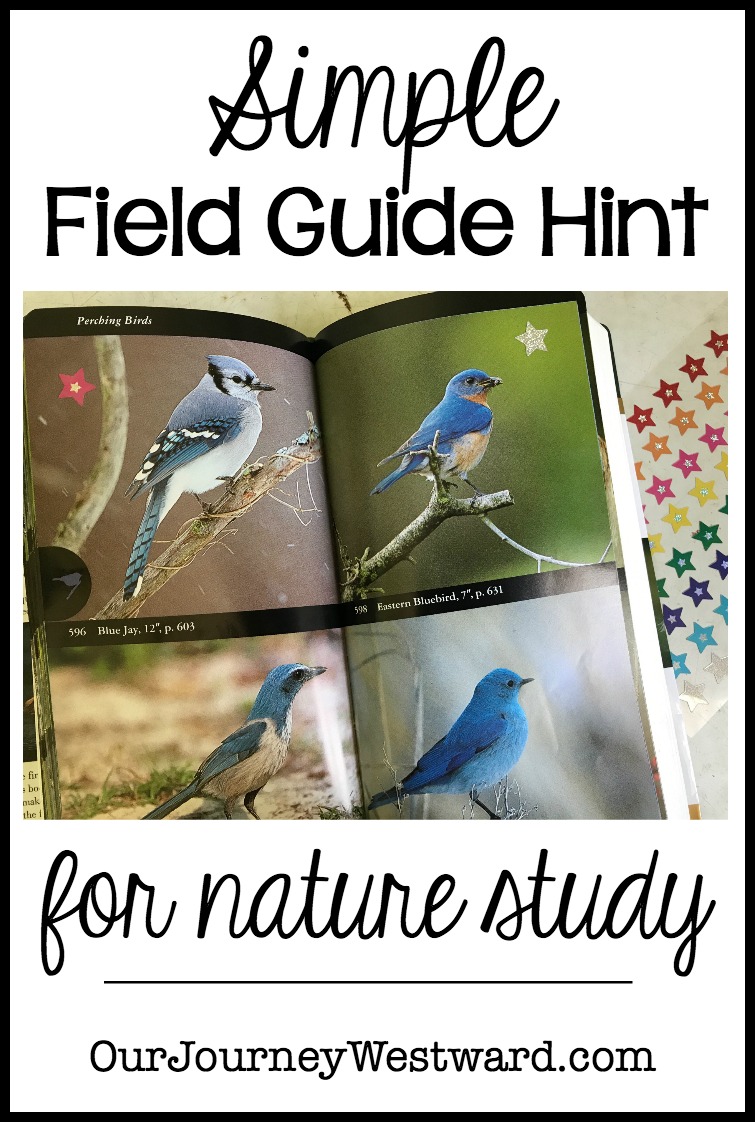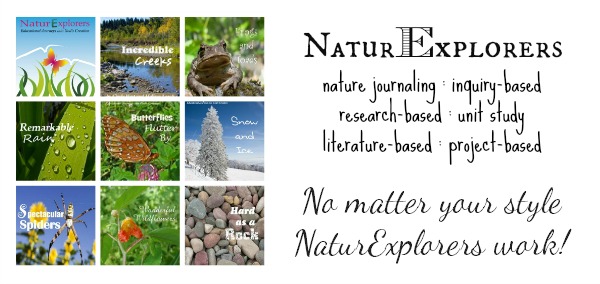Simple Field Guide Hint
Here’s a simple field guide hint that will work for all ages from preschool through adult. We started using this little trick before our children were even readers and we still use it to this very day.

Simple Field Guide Hint
Get out the stickers!
Before they could write, or even draw very well, I wanted a way for my children to note the plants or animals we had identified. I pulled out a sheet of mini-stickers and we placed a sticker on each picture as we came across something during our nature walks.
As the children have grown, we haven’t stopped marking our field guides with stickers. It’s proven to be a great tool for all of us in remembering what we’ve already identified – and in learning names of plants or animals quickly.
I keep a small sheet of stickers tucked into every one of our field guides for quick and easy marking as we walk.

Isn’t that easy? And, it’s surprisingly motivating! Since early this spring, we’ve kept the bird field guide handy and everyone is having fun adding stickers as new birds come and go.
This idea is a perfect addition to any NaturExplorers curriculum guide! No matter the topic you choose, simply carry along an appropriate field guide whenever you head out for a nature walk.
Field Guides I Love
I’m always asked which field guides are best for nature walks. I’m not a field guide snob, so I’m very happy to have any I can get my hands on. However, I love the ease of use and durability of the National Audubon Society’s field guides.
They have a guide on just about any nature topic you can imagine. The first half of each guide is full of large, full-color pictures of various species; each grouped together by types and/or colors. So…if you want to identify a purple flower, for instance, you will flip right to the purple section of pictures.
The second half of each guide includes the nitty-gritty information about each picture. There are descriptions to help you be sure you’ve identified the correct image as compared to your specimen (which is very helpful.) Additionally, you’ll learn things about location, habits, habitats, and more depending on what type of plant or animal you’re studying.
Maybe my two favorite aspects: The covers are made of a durable, protective plastic and the guides are relatively compact. In other words, they’re easy to pack along on nature walks and hold up to lots of use.
This post contains affiliate links.
National Audubon Society Field Guide to North American Birds: Eastern Region, Revised EditionAudubon Society Field Guide to North American Trees: Eastern Region
National Audubon Society Field Guide to Rocks and Minerals: North America (National Audubon Society Field Guides (Paperback))
National Audubon Society Field Guide to North American Mushrooms (National Audubon Society Field Guides (Hardcover))
National Audubon Society Field Guide to North American Wildflowers–E: Eastern Region – Revised Edition (National Audubon Society Field Guides (Paperback))
National Audubon Society Field Guide to Insects and Spiders: North America (National Audubon Society Field Guides (Paperback))
The National Audubon Society Field Guide to North American Butterflies
National Audubon Society Field Guide to North American Mammals (National Audubon Society Field Guides (Hardcover))
Nature Study is Worth It
I’ve written before about the incredible benefits of nature study as part of your homeschool. But, did you know how much serious science you can learn through nature study? Check out the post below.
How To Do Nature Study
I’m not going to pretend to have THE perfect method of studying nature because I feel like each family should do what works best for them. However, I do have several resources that might help you along the way…
If you’re already serious about nature study and need some fresh ideas to get you moving in a new direction or to help you dive deeper, you’ll want to look into the NaturExplorers series. You’ll be able to choose from 19 different topics that will each offer 20-40 creative nature walks (some with notebooking pages), plus a ton of follow-up learning ideas for research projects, model-making, experiments, and more.
(The NaturExplorers curriculum guides ⇈ are perfect for Charlotte Mason homeschoolers because of all the cool extras like living literature lists and artist/composer/poetry selections.)
If you’re just beginning to dabble in nature study and/or you just don’t know where to begin and/or your children say they hate it, I think you’ll find 100+ Creative Nature Walks or 40 Nature Walks: Outdoor Science Labs On the Go (coming soon!) to be just the ticket.
-
 Creative Nature Walks$24.00
Creative Nature Walks$24.00
Do You Love Nature Study?
I’d really love to hear about your successes, failures, and fears. Let’s talk in the comments.




